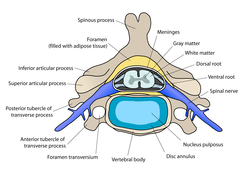
Back Nekwerwel Afrikaans فقرة عنقية Arabic Boyun fəqərələri Azerbaijani Муйын умыртҡалары Bashkir Mell ar gouzoug Breton Vratni pršljenovi BS Vèrtebra cervical Catalan Krční páteř Czech Мăй сыпписем CV Cervikale vertebrae Danish
| Cervical vertebrae | |
|---|---|
 | |
 A human cervical vertebra | |
| Details | |
| Identifiers | |
| Latin | vertebrae cervicales |
| MeSH | D002574 |
| TA98 | A02.2.02.001 |
| TA2 | 1032 |
| FMA | 9915 |
| Anatomical terms of bone | |
In tetrapods, cervical vertebrae (sg.: vertebra) are the vertebrae of the neck, immediately below the skull. Truncal vertebrae (divided into thoracic and lumbar vertebrae in mammals) lie caudal (toward the tail) of cervical vertebrae.[1] In sauropsid species, the cervical vertebrae bear cervical ribs. In lizards and saurischian dinosaurs, the cervical ribs are large; in birds, they are small and completely fused to the vertebrae. The vertebral transverse processes of mammals are homologous to the cervical ribs of other amniotes.[citation needed] Most mammals have seven cervical vertebrae, with the only three known exceptions being the manatee with six, the two-toed sloth with five or six, and the three-toed sloth with nine.[2][3]
In humans, cervical vertebrae are the smallest of the true vertebrae and can be readily distinguished from those of the thoracic or lumbar regions by the presence of a foramen (hole) in each transverse process, through which the vertebral artery, vertebral veins, and inferior cervical ganglion pass. The remainder of this article focuses upon human anatomy.
- ^ Schilling, N (10 February 2011). "Evolution of the axial system in craniates: morphology and function of the perivertebral musculature". Frontiers in Zoology. 8 (4): 3–4. doi:10.1186/1742-9994-8-4. PMC 3041741. PMID 21306656.
- ^ Varela-Lasheras, Irma; Bakker, Alexander J; Van Der Mije, Steven D; Metz, Johan AJ; Van Alphen, Joris; Galis, Frietson (2011). "Breaking evolutionary and pleiotropic constraints in mammals: On sloths, manatees and homeotic mutations". EvoDevo. 2: 11. doi:10.1186/2041-9139-2-11. PMC 3120709. PMID 21548920.
- "Sticking their necks out for evolution: Why sloths and manatees have unusually long (or short) necks". ScienceDaily (Press release). May 6, 2011.
- ^ Galis, Frietson (1999). "Why do almost all mammals have seven cervical vertebrae? Developmental constraints, Hox genes, and cancer". J. Exp. Zool. 285 (1): 19–26. doi:10.1002/(SICI)1097-010X(19990415)285:1<19::AID-JEZ3>3.0.CO;2-Z. PMID 10327647.
© MMXXIII Rich X Search. We shall prevail. All rights reserved. Rich X Search